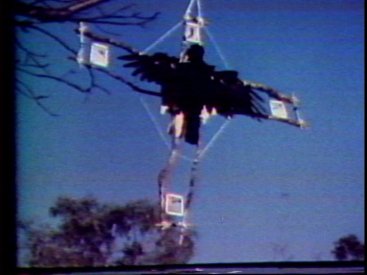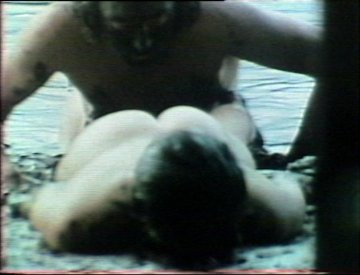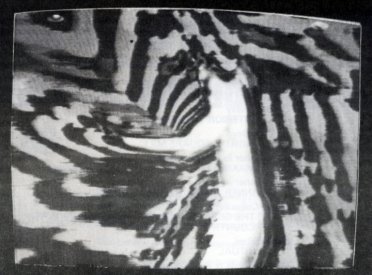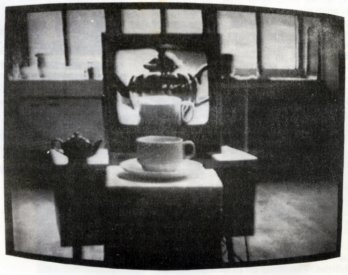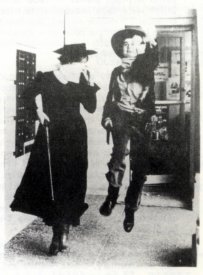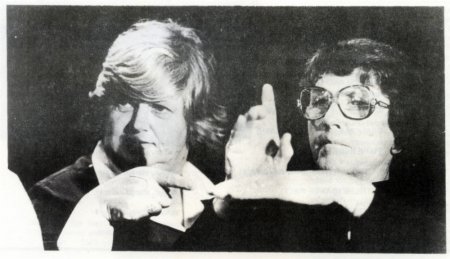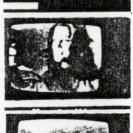Organised for tour of North America by Stephen Jones and Bernice Murphy for the Australian Gallery Directors Council, Sydney, 1979; presented at the Art Gallery of New South Wales, Sydney.
“The TV image is not a still shot. It is not a photo in any sense, but a ceaselessly forming contour of things limned by the scanning-finger. The resulting plastic contour appears by light through, not light on, and the image so formed has the quality of sculpture and icon, rather than of picture. The TV image transmits some 3 million dots per second to the receiver. From these he accepts only a few dozen each instant, from which to make an image.”
– Marshall McLuhan, Understanding Media, 1964
“The long suffering TV public who have invested a thousand dollars on the most complex piece of instrumentation in their home should have access to many forms of information, rather than ... [imported] programs. But who needs an imported culture when we have a unique one of our own which demands vigorous expression and all you have to do is to feed back on it for it to become tangible and take its rightful place as the soul of the nation.”
– Ariel, Australian video artist, City Video National Resource Centre, Report 1974–75, Sydney, 1975
“The miracle of instantaneity ... is a miracle with no equivalent in the history of art. Never before has an artist been able to summon instantaneously an image which reconstitutes itself ceaselessly before our eyes, at a prodigious speed.”
– Rene Bauermeister, German video artist, in Studio International, May–June 1976
“... objectivity is a non-existent linguistic illusion ... I’m interested in the failure of language ... [and] non-physical systems.”
– Stephen Jones, Australian video artist, interviewed in Videography, New York, February 1980
Despite the ubiquitous presence of broadcast television in our lives, the sense of what is experimentally possible in the ‘video space’ that is projected on a video screen is still little appreciated.
The spontaneous realism, immediacy and vast audience potential of television made it early suited to mass cultural occasions and macro-cultural information. One of the first public broadcasts of a mass cultural event occurred with the live transmission of the Berlin Olympic Games in 1936 (although Britain was engaged in experimental television broadcasts a decade earlier). Significantly it was a later Olympic occasion — the games in Melbourne in 1956 — that brought television to the public in Australia.
The simultaneity and ‘real time’ nature of television, its automatic synchronisation of image and sound, and especially its veracity and easy accommodation to the everyday domestic urban environment, survive as strongly as ever as the medium’s most innate and insistent characteristics. The transmission of an electronic signal to display monitors subverted much of the artifice of film; instead of chemicals and spliced strips, the abstraction of time and disembodied group of eyes in the dark essential to the film medium, television emerged into the bright unstructured environment of daily life, as familiar as refrigerators.
While television’s inherent realism causes its early co-option to the modes of news reportage, documentary, drama, feature and liveshow — all modes which were served by logical, linear and verbally-based presentation — the more visually abstract, laterally structured, expressionist and contemplative potential of the new medium of video was neglected. Television quickly spawned an industry dedicated largely to mass cultural entertainment and partially to public news and information. Involving enormously expensive equipment and centralised resources and personnel, television long remained beyond the reach of artists and of those who wished to explore its potential to democratise information on a vast scale and be an agent of heightened social awareness and change.
A revolutionary transition in the potential of video occurred in the late 1960s with, as is often the case, a major technological development emerging through a military machine. Out of American aerial surveillance technology developed for use in Vietnam came the affordable Portapak ½ inch video equipment, which expanded the ‘heliscan’ and took video out of the high-technology 2-inch broadcast studios and made it accessible to artists, social activists and technological tinkers in a host of far-flung environments. Yet for all the developments in experimental video in the 1960s and 1970s, the economics and politics of broadcast control are such that ‘video art’ remains generally ghettoised. It is relegated to the margins of our culture.
The continued confinement of experimental video, and its almost total pre-emption by the ‘frightful parent’ medium of broadcast television (David Antin’s term), remains a distinctive irony of our contemporary culture — for video is the most expressive medium of contemporary culture. Bertolt Brecht’s percipient vision of the socially fluent and reflexive possibilities of radio as an ever more transparent medium which could be transformed by input from audiences as well as broadcasts to them, has been well advanced already in such exciting radio ventures as the ABC ‘Broadband’ programs (in pre-budget cut days). But the even more interesting possibilities of multi-valency in broadcast video remain tantalising phantasms of the future in Australia.
The irony of video’s position is sharpened when one realises that, unlike the wide functional and syntactical gap that separates Super 8 experimental film and cast-and-crew professional movies, TV and video are experienced by the viewer through the same technological vehicle: they both compete for the same monitor — with television (as far as airtime goes) winning all the way.
Reference first to the broad cultural context of television is important as a means if approaching the special essence of video; video cannot fully be understood without reference to the social and technological conditions of its production and operation.
The visual medium which most strikingly emulates human sensory capacities, video is also a complex time-image machine which changes our sense of the world, and of reality, just as the development of photography did earlier. (In a post-photographic age we can never again quite have that Pygmalionesque sense of wonder at the veracity of earlier paintings, which seem more easily read as artifacts than as belief-teasing illusions of the real world.)
Striking for its immediate and informal delivery of naturalistic images in real time, video also permits the most abstract kinds of conceptualising and image-making. It is an immaterial medium, like film, which vanquishes earlier associations of art objects with physicality: facture, surface, patina, mass, weight and tactile qualities are irrelevant to the images generated by the dots and lines scanned on a video screen. However, unlike film, video does not consist in the animation of a sequential, chain-like structure of image-frames which can be separated and analysed as discrete units. Video images are realized in an electronic gestalt context, in which optical and audio information are translated simultaneously into electronic signals and displayed on a video screen.
The production and display of images on a video screen therefore offers a closer analogy to human vision and consciousness than any other visual medium. It does not involve translation through an intermediary language (words) or vehicle (paint or drawn line); the images are immediately apparent to a viewer — who may (through video’s unique capacity for instant feed-back) be the producer/viewer simultaneously.
The closed-loop experience of video is unique to its technology and expressive possibilities. The situation in which an image is recorded by a camera, transferred to a monitor from which it may be picked up and reacted to by a producer/viewer, causing a modification in his or her behaviour, may be described functionally as a triangular configuration. Video is peculiarly suited to behavioural reflex through its incorporation of real time and its natural tautology of set-up.
The term ‘experimental video’ embraces a wide range of videotapes (usually circulated or sold as ¾ inch copies from originals) which cover a broad territory of experimentation with the medium, pressing out beyond the confining conventions of television. The present selection of videotapes made recently in Australia covers the spectrum of video work evident in other countries: from socially and politically oriented tapes, to documentations of performance art and related activities, to the more electronically preoccupied area of image-processing and synthesising.
It is important to realise, however, that the diverse production of experimental video in the 1960s and 1970s occurred not through any linking factor of convergence of ideas related to the medium of video, so much as part of a common move by many artists away from more traditional kinds of art activity. Experimental video really emerged strongly out of the environment which produced conceptual art.
The present program of recent Australian videotapes was compiled originally for tour abroad by the Australian Gallery Directors Council in 1979. Organised by Stephen Jones and Bernice Murphy and toured under the title Videotapes From Australia, the program was shown at The Kitchen Centre for Video and Music, New York, in November 1979, and subsequently at the Los Angeles Institute of Contemporary Art, Los Angeles, December to January 1979–80. In March this year it was presented at the Video Inn, Vancouver, Canada. The program was accompanied during its North American showings by Stephen Jones, who assisted in installation and presentation of the tapes at the various venues.
Following its return, the program is presented to an Australian audience for the first time as part of the Project series of exhibitions at the Art Gallery of New South Wales. Meanwhile the same program has recently been invited by the organising committee of the 1980 Biennale de Venezia to be shown as an associated event in Venice, opening at the end of May.
Bernice Murphy
Curator of Contemporary Art
